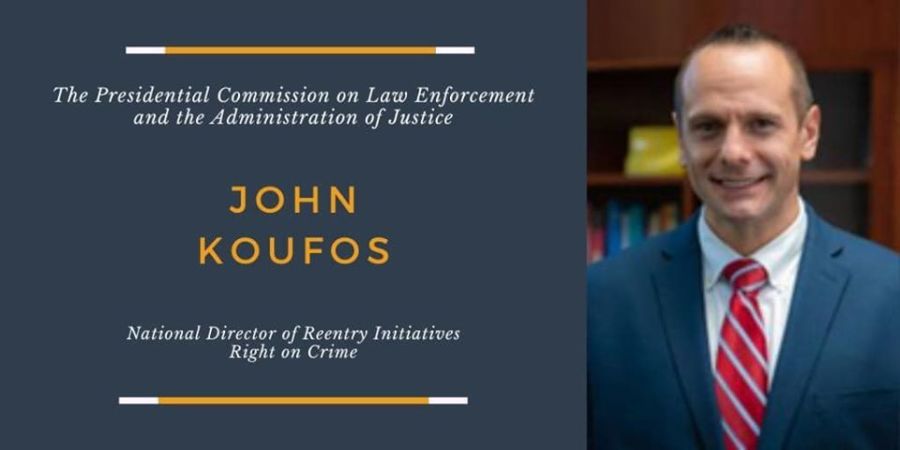John Koufos, National Director of Reentry Initiatives for Right On Crime, recently testified before the Presidential Commission on Law Enforcement and the Administration of Justice on effective reentry strategies for those rejoining society from incarceration.

United States Attorney General William Barr established the commission earlier this year, per the President’s executive order, to explore modern issues affecting law enforcement that most impact the ability of American policing to reduce crime.
Over 95% of prisoners sentenced to serve time in a state prison will ultimately reenter society, how America handles incarceration and the reentry process for those leaving incarceration has profound effects on our society and public safety. Well-designed reentry policy and practice can assist individuals in becoming employed, law-abiding, tax-paying citizens who are also able to pay child support and victim restitution.
During his testimony, Koufos highlighted the following three specific interventions which are critical to reducing systemic barriers for returning citizens and simultaneously promoting community wellbeing:
Ensure Everyone Leaves Incarceration with a Department-of-Motor-Vehicles-Issued Non-Driver Identification Card or Driver’s License
While procuring a non-driver state identification card (ID) or driver’s license may sound simple, it is certainly not easy. Many returning citizens lack the necessary identification documents (such as birth certificates and social security cards) and proofs of residence. Valid identification is a prerequisite for participation in the economy, including employment, housing, healthcare, and social service programming, and is cited by research partners at Florida State University as one of the greatest challenges for reentrants. Furthermore, parole and probation conditions often mandate housing, employment, or treatment, and lack of identification prevents individuals from meeting these requirements and contributes to high recidivism rates stemming from supervision violations.
Prisons, state vital statistics offices, and state departments of motor vehicles (DMVs) must all work together to coordinate identification procurement for inmates so that they have an honest chance to reintegrate holistically without being artificially hindered by lack of identification.
Create a System to Resolve Fines, Fees, and Low-Level Charges Before Release
Even if a returning citizen has valid state identification, he or she may still not be able to obtain a driver’s license due to outstanding fines, fees, and warrants. These unaddressed obligations can result in license suspension and prevent DMV offices in forty-four states and the District of Columbia from issuing or renewing a person’s driver’s license. Nationally, there are more than 11 million debt-related driver’s license suspensions, which even affect many without criminal histories, as many citizens, particularly in rural areas, struggle to access transportation to travel to work, doctors, or address other critical needs.
In order to solve this problem, state DMVs must work together with prisons to provide a list of all outstanding fines and fees at least a year prior to release. That list, known as an “obligation report” in most states, is a roadmap to driver’s license restoration. Koufos created the largest system of its kind in New Jersey, during his time at the New Jersey Reentry Corporation (NJRC), which resulted in over 400 restored driver’s licenses, thousands of identity documents, hundreds of vacated warrants for low level, largely non-criminal, and tens of thousands of dollars in forgiven, mitigated, or paid fines.
Establish Connections to State Labor Departments and/or Local American Job Centers
Securing steady employment is vital to re-establishing a stable life post-incarceration. Living-wage jobs allow reentrants access to a sense of purpose and community, to pay off outstanding child support payments, court fines and fees, and victim restitution, and contribute to the economy as taxpayers and consumers. Despite its importance, access to employment after prison is an often-cited barrier to successful reintegration.
In order to assist reentrants with finding employment, local American Job Centers and state departments of labor should connect inmates with education and training pre-release and help find jobs using those skills shortly post-release. Returning citizens should be registered with the U.S. Selective Service System and the local American Job Centers pre-release to ensure a warm hand-off. These steps will increase employment opportunities for returning citizens and help them become more attractive to employers.
By linking resources and agencies that already exist in the government structure, officials can greatly reduce both administrative and eligibility barriers for returning citizens and give them a real chance at a second chance.